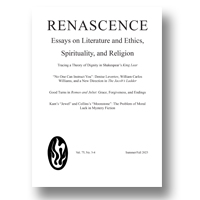|
|
|
1.
|
Renascence:
Volume >
76 >
Issue: 2
John Curran
Editor’s Note
view |
rights & permissions
| cited by
|
|
|
|
|
|
|
2.
|
Renascence:
Volume >
76 >
Issue: 2
Edwin Block
‘A Less Than Perfect Instrument’:
Barbara Ehrenreich’s Struggle With the Ineffable
view |
rights & permissions
| cited by
|
|
|
|
|
|
|
3.
|
Renascence:
Volume >
76 >
Issue: 2
Michelle Eshbaugh-Soha
Radical Love in Shakespeare’s King Lear
view |
rights & permissions
| cited by
|
|
|
|
|
|
|
4.
|
Renascence:
Volume >
76 >
Issue: 2
Yanbin Kang
Dickinson’s (Non)-Seeking, Pearl Narrative, and Emerson/Thoreau
view |
rights & permissions
| cited by
|
|
|
|
|
|
|
5.
|
Renascence:
Volume >
76 >
Issue: 2
Notes on Contributors
view |
rights & permissions
| cited by
|
|
|
|
|
|
|
6.
|
Renascence:
Volume >
76 >
Issue: 1
Benjamin Porter
St. Thomas Aquinas and Final Causation in The Violent Bear it Away
abstract |
view |
rights & permissions
| cited by
Though it’s often said that St. Thomas Aquinas was important to Flannery O’Connor’s theology, few have noted his relevance to her craft approach. By joining Thomas’s action theory to his psychology, O’Connor developed notions of character and plot which are at their most mature in her final novel, The Violent Bear It Away. In it, O’Connor structured her characters by dramatizing Thomas’s doctrine of final causation, a metaphysical explanation of desire, to create dramatic mystagogy. Understanding her creative process this way gives insight into her novel, making sense of opaque moments in the text. Moreover, by understanding final causation, classic criticisms of the novel are put into context. Some have claimed her characters’ actions are overdetermined by her theology. However, understanding O’Connor’s project allows her to respond, making intelligible her craft choices against this criticism. Therefore, it’s by understanding O’Connor’s adaptation of Thomas for literary ends that fresh interpretations of The Violent Bear It Away are made available.
|
|
|
|
|
|
|
7.
|
Renascence:
Volume >
76 >
Issue: 1
N. S. Boone
Dualism and Christian Hope in Marianne Moore’s “The Fish”
abstract |
view |
rights & permissions
| cited by
This article provides a close reading of Marianne Moore’s “The Fish,” asserting that it’s imagery should be understood allegorically to represent the split between the physical and the spiritual, or temporal and eternal. In particular, the image of the cliff represents the dualistic nature of humanity—one side physical (and continually eaten away by the encroaching sea), and the other side spiritual. Many readers of Moore have not been able to explain how the cliff can be seen at once to be defeated by the sea on one side, but yet triumph over it on the other. An Christian-allegorical reading, based in Moore’s life-long Protestant faith and her in-depth Bible studies, provides an explanation that makes sense of the imagery.
|
|
|
|
|
|
|
8.
|
Renascence:
Volume >
76 >
Issue: 1
Qixia Chen, Aihua Chen
The Redemptive Implications of Chen Qiufan’s Waste Tide
abstract |
view |
rights & permissions
| cited by
Waste Tide, Chen Qiufan’s debut sci-fi novel, has received growing critical attention. While most of the scholarship focuses on the explicit themes of globalization, post-human, cyborg, and alienation, the perspective of Christianity and the redemptive implications it reveals have not been given due attention. Christian stories and doctrines referred to in the novel are quite closely related to the theme of the redemption of the characters. By presenting the characters’ redemption journey with Christian principles, Chen Qiufan reveals their complex inner world and points out the ways to realize self-redemption. This paper argues that Waste Tide can be most meaningfully interpreted as a story of sin and redemption by utilizing the genre of science fiction. Love, forgiveness, confession, and atonement are emphasized in the novel to serve as the remedies for fallen humanity in a world of technological development and global capitalism. A thorough analysis of the Christian underpinning in this novel reveals Chen Qiufan’s strength in characterization and presenting important moral concerns in a world dominated by technoscience through the Christian voice.
|
|
|
|
|
|
|
9.
|
Renascence:
Volume >
76 >
Issue: 1
Michele Valerie Ronnick
Why is Milton ‘Milto’? Giovanni Salzilli, John Milton, and Aelian
abstract |
view |
rights & permissions
| cited by
In 1638 the Italian scholar Giovanni Salzilli sent the young John Milton who had recently arrived in Italy a short Latin poem in which Salzilli addressed Milton as ‘Milto.’ He did not use the more commonly found form of Milton’s Latin name, Miltonus and Miltonius. Using archival and print materials as evidence this paper examines this apparent hapax legomenon and suggests that its source can be found in Aelian’s Varia Historia.
|
|
|
|
|
|
|
10.
|
Renascence:
Volume >
76 >
Issue: 1
Notes on Contributors
view |
rights & permissions
| cited by
|
|
|
|
